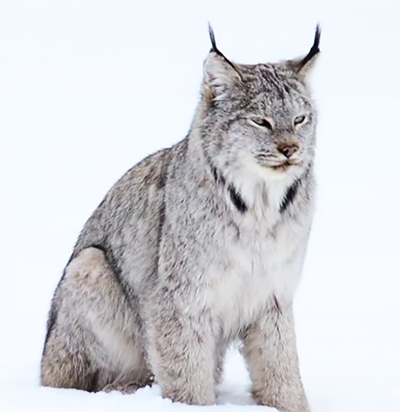Canada Lynx
 The Canada lynx is lord of the hunt, created by winter itself, with natural snowshoes formed by thick cushions of hair on the soles of their feet and long legs. These adaptations uniquely enable them to stalk the main staple of their diet — the snowshoe hare — killing an average of one hare every two or three days. When hares are scarce, they will hunt rodents, grouse, and other small animals.
The Canada lynx is lord of the hunt, created by winter itself, with natural snowshoes formed by thick cushions of hair on the soles of their feet and long legs. These adaptations uniquely enable them to stalk the main staple of their diet — the snowshoe hare — killing an average of one hare every two or three days. When hares are scarce, they will hunt rodents, grouse, and other small animals.
The Canada lynx is a medium-sized cat with long legs - about 20 inches tall at the shoulder, weights around 20 pounds, and is about 32 inches long. They are known for their long, black ear tufts and short, black-tipped tails.
Native to Oregon, as well as other states, the Canada lynx falls prey to man, to fatten his purse with the fur trapper's ill-gotten gains in addition to what is called "incidental trapping" - caught in traps and snares set for other species.
In the 1970s and 1980s, the price for lynx hides reached as high as $600 each, making them a clear candidate for Endangered Species Act protection. Although Fish and Wildlife Service field biologists and three out of four regional offices supported protection, the Washington, D.C. headquarters denied it.
Since the 1800s, trapping has taken a heavy toll on the Canada lynx, but in more recent times, the additional threat of habitat destruction through indiscriminate logging, fragmentation of range by ever increasing roads, motor vehicle mortalities - human encroachment. In 1995, Congress enacted a law that demanded 330 "salvage sales" on national forests, protecting the sales from court appeal by excepting them from safeguards of environmental laws and then set logging at an unsustainable level for many forests.
Lynx, bobcat, and cougar are the three wild cat species in North America with lynx being the most scarce of the three. Only a few hundred are believed to remain in the U.S. Canada lynx require the intervention and support of conservationists to avoid the total extinction experienced by their relative, the eastern cougar.
Current Threats
- Logging, tree thinnning, and fire suppression efforts that alter forests.
- Human intrusion, including road building, trails, and the invasion of off-road vehicles and snowmobiles.
- As is the case with all wildlife, including on public lands, trapping puts lynx in Oregon at risk. Traps are non-descriminate, so a threat to any animal that can trigger them.
Quick Facts
- Lynx populations can only be sustained where there are adequate snowshoe hare populations, but lynx are also known to eat carrion, grouse, ptarmigan, mice, red squirrels, and voles.
- Lynx hunt and travel alone.
- Lynx are slightly more active at night than day.
- Lynx have excellent eyesight and can spot a mouse at 250 feet.
- The Oregon population of Canada Lynx - if any - is unknown.
- Forest Carnivore Research in the Northen Cascades of Oregon, Oc 2012 - May 2013, Oct 2013 - June 2014 reports not a single Canada Lynx was found.
- OFW notes there have been 72 lynx sighting reports, including one specimen that was shot in 1993.
Sources
"Basic Facts About Canada Lynx." Defenders of Wildlife. 2012. Web. 2 Feb. 2016.
Cables, Rick D. Colorado Fish and Wildlife Service. USDA, July-Aug. 2008. Web. 9 Nov. 2015. http://www.fs.usda.gov/Internet/FSE_DOCUMENTS/stelprdb5357385.pdf.
"Canada Lynx Conservation Agreement with the Forest Service." FS USDA. U.S. Forest Service and U.S. Fish and Wildlife Service, July-Aug. 1998. Web. June-July 2015. http://www.fs.usda.gov/Internet/FSE_DOCUMENTS/stelprdb5160661.pdf.
"Canada Lynx Conservation Agreement with the Forest Service." United States Department of the Interior. USDA, Aug.-Sept. 2006. Web. 8 Sept. 2015. http://www.fs.usda.gov/Internet/FSE_DOCUMENTS/stelprdb5160663.pdf.
"Canada Lynx Habitat and Linkage Zones for Forest Service Lands of the Northern Rockies Lynx Amendment Area." - ScienceBase-Catalog. Web. 27 Feb. 2016. https://www.sciencebase.gov/catalog/item/5473b243e4b0b935bc7716a4.
McFadden-Hiller, Jamie E., and Tim L. Hiller. "Forest Carnivore Research in the Northern Cascades of Oregon." Final Progress Report. ODFW. Web. 3 Apr. 2015. http://www.dfw.state.or.us/resources/hunting/small_game/docs/forest_carnivore_project_report_hiller.pdf.
"ODFW - Canada Lynx." ODFW - Canada Lynx. Web. 27 June 2016.
"Threatened, Endangered, and Candidate Fish and Wildlife Species in Oregon." ODFW. ODFW. Web. 7 June 2015. http://www.dfw.state.or.us/wildlife/diversity/species/docs/Threatened_and_Endangered_Species.pdf.
